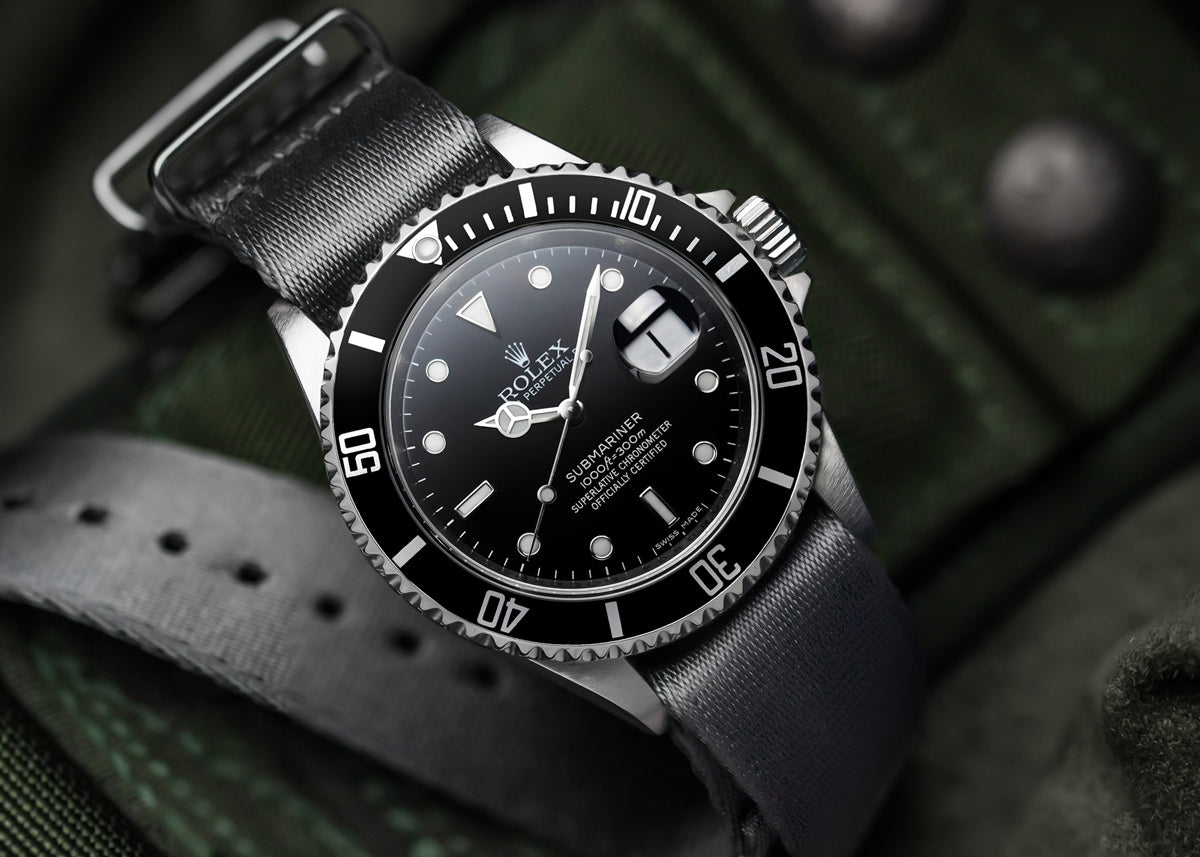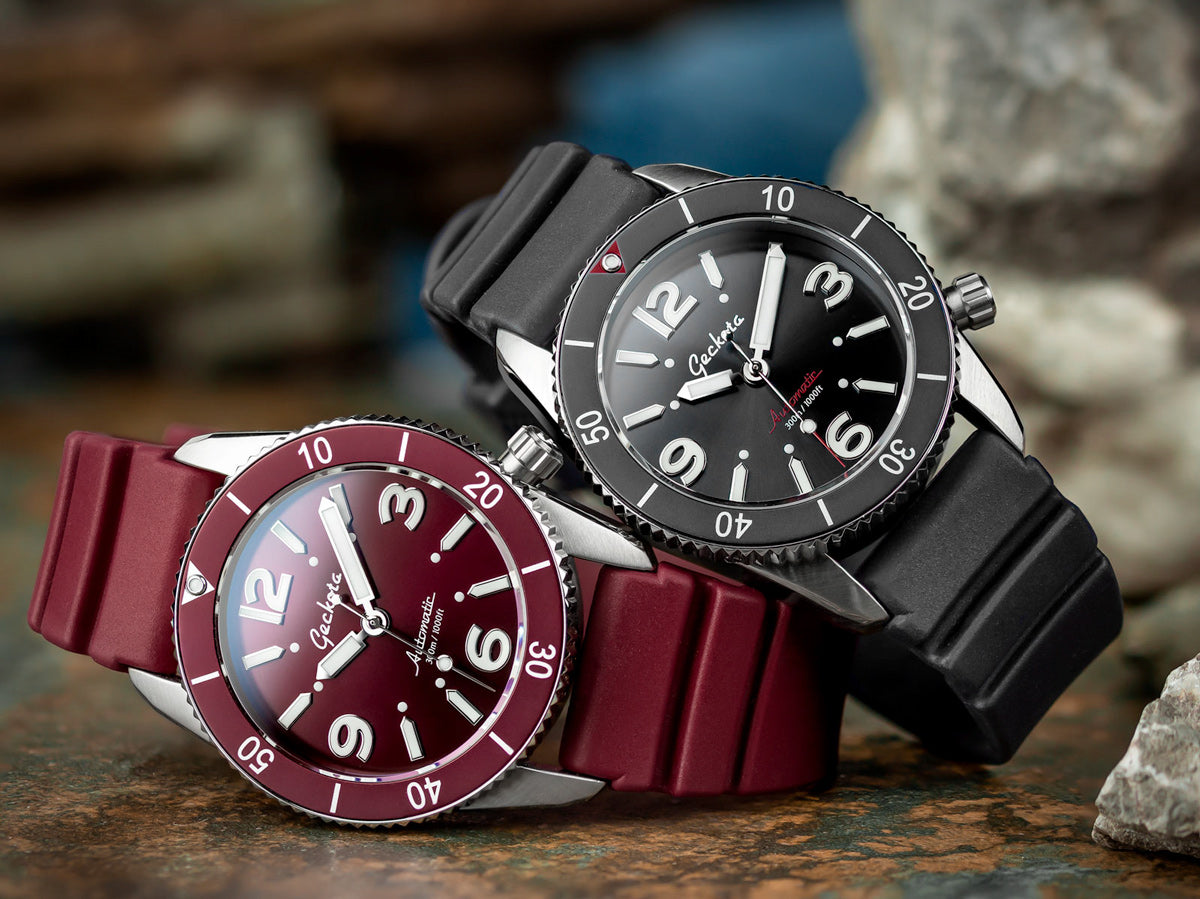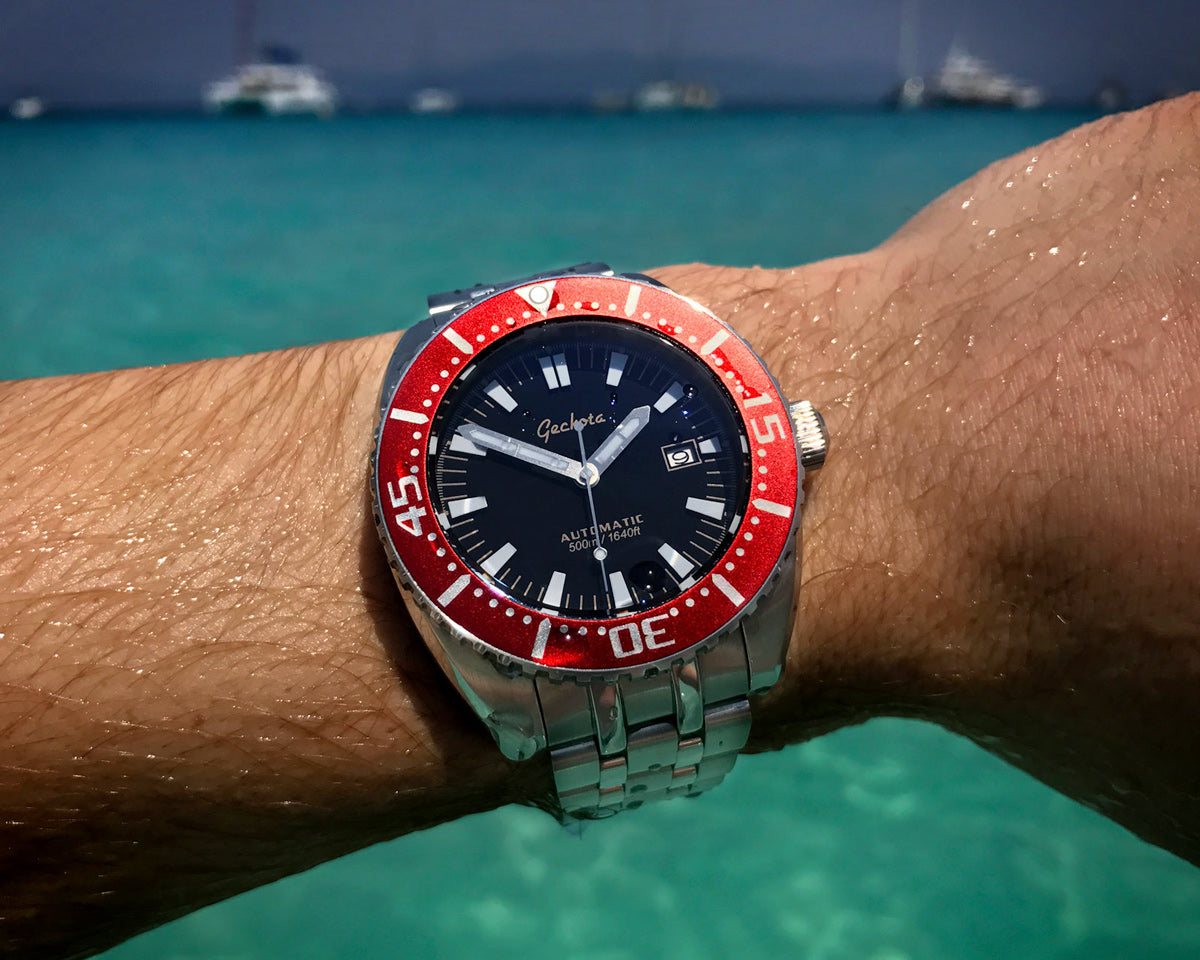What is watch water resistance? What does water resistant mean? Read our team’s tips on water resistant watches and keeping them that way.
It’s 1927 and swimming stenographer Mercedes Gleitze famously wears a water-resistant Rolex Oyster in the English Channel. Ninety years later, in Antarctica’s frigid waters, Laurent Ballesta wears a Blancpain while photographing ‘The Ice Monster’. At the same time, maybe you rocked a favourite TAG-Heuer while scuba diving; and I wore my Orient Mako while washing the car. In each case, the watch resisted water. Whether I desk-dive with my Orient or Ballestra explores with his Blancpain X Fathoms, we take water resistance for granted. But how are watches made water resistant, what does ‘Diver’s 200m’ really mean, and how do we preserve our watches’ water resistance?
Unstrap your watch; look closely at the dial and case back. With the exception of some vintage watches, like the Polerouter Super I’m wearing, expect to see words like ‘Water Resistant’,‘200m, ‘ISO 6425’,‘10 ATM’ or ‘WR 30 bar’. All relate to manufacturers’ tested water resistance. Decoded accurately – it’s important to do so – the watchmaker’s shorthand guides what you can safely do in water with your watch: 30m? Walk in the rain with someone you love; 300 m? Serious scuba diving; 1000m? How about professional saturation (SAT) diving…
Actually, it’s more complicated because of other factors such as steam, proper maintenance, specific use regimes and time influence the maintenance of your watch’s specified water resistance.
Water resistance is impermanent
You see, whether it’s a £100 Invicta or £100k Richard Mille, watch water resistance is ultimately impermanent. It varies with the watch’s design and engineering, how and where you use your watch. And then there’s time; once your new watch is out of warranty, water resistance can become less predictable.
Widely used water resistance measures
Let’s look at some of the main water resistance measures. First, let’s bring bars, atmospheres, feet, and metres into alignment: 1 bar, atmospheric pressure at sea level, is 1 atmosphere, 33 feet, 10 metres or 14.7 pounds per square inch (PSI). At the other extreme of watch water resistance, 5000m (think of Sinn’s UX mission timer), equates to 16,404 feet, 500 atmospheres or a whopping 7,111 PSI.
ISO 22810 and ISO 6425
The minimum water resistance to meet ISO 22810:2010, Horology – Water resistant watches (for daily use) is 2 bar. In practice, reputable brands generally offer at least 3 bar. There’s a separate standard, ISO 6425, for diving watches – if you see “Diver’s” on a watch dial, it’s ISO 6425 compliant.
Here’s a rough guide to ratings and their meaning in practice. NOTE: if in doubt, always follow your watch manufacturer’s recommendations.
What does water resistant really mean?
In The Magic of Watches, Louis Nardin says the most important factors [for a watch] are precision, water resistance, and dust and shock resistance.
Water resistance (‘WR’) is your watch’s capability to withstand water, dirt and moisture ingress at specified pressures. High water resistance means high dirt resistance too; even if your dive watch never gets wet, you can reasonably expect its 200m water resistance to give enhanced protection against that other enemy of watches – dust.
Waterproof or water resistant?
Decades ago, ‘waterproof’ was a widely used descriptor. This changed noticeably with the emergence of increasingly litigious consumer environments in the 1960s. Nowadays, with maybe one notable exception, ‘water resistant’ is the norm. The specific use of ‘water resistance’ is significant. Strictly, no watch is waterproof, though Anthony L (100+ No BS Watch Tips for Watch Enthusiasts and Salespeople) maintains that only Rolex can use this descriptor. He maintains that they’ve demonstrated to the USA’s Federal Trade Commission that their watches are indeed waterproof. ‘It’s because,’ the author concludes, ‘Rolex got together with the FTC and demonstrated this that they’re allowed to use waterproof in their advertising…this is how Rolex uses “waterproof” to their advantage. They’re not saying that their watches are waterproof in the definition sense (that no water can penetrate it ever). They’re using it in an extremely defined setting (that no water can ever penetrate it to the depth that they specified).’
In their brochure Rolex frequently write ‘waterproof’ and ‘waterproofness’. For example, ‘Today, a Rolex watch case is waterproof to a minimum depth of 100 metres (330 feet) for Oyster models, and 50 metres (165 feet) for Cellini models.’ It’s the same claim that accompanied 1953’s original Submariner Ref. 6204.
How are watches made water resistant?
Waterproof or water resistant, the basic principles that Rolex introduced in 1926 have subsequently been developed and enhanced with new technology and manufacturing techniques. Nevertheless, the basics are unchanged. Gaskets and seals – they make-up five of the current Rolex Triplock’s 10 parts – protect water-vulnerable points of entry to the watch movement. For instance, where the case back attaches, the crystal, the winding crown and pushers.
Another point often overlooked when considering water resistance is the role of self-winding movements. With 1931’s Rolex Oyster Perpetual, the need to regularly unscrew the crown for winding disappeared – along with many opportunities for moisture ingress.
Testing water resistance in watches
Essentially, pressure and water resistance, whether during design, manufacture, maintenance or repair, involves dry and wet tests under strictly controlled conditions.
Air testing
Water resistance is tested first, with air tests at high and low pressures. Perhaps counter-intuitively, low pressures, as found in aircraft, plus water vapour, or steam at atmospheric pressure in homes or leisure centres, are among the cruellest watch tortures. Louis Nardin again: ‘…the mixture of normal or low pressure with steam is the worst combination for your watch.’
Static water testing
Next, watches are submerged in test cylinders filled with demineralised water and pressure tested (corresponding to required test depths) for at least an hour. Some manufacturers add substantial margins to allow for the difference between the test’s static pressure and dynamic pressures encountered during swimming. Speaking with Certina at Baselworld 2018, I learned that my DS Action watch, officially 30 bar (300m) rated, was actually wet-tested to 375m. That’s on par with the additional testing that Rolex apparently does. And others: Bremont’s Nick English: ‘…Supermarine watches are tested far beyond [ISO standards]. The Supermarine S500 for example, with the solid case back, although it has 500m written on the dial, is tested to over 1400m…’
Humidity testing
A third test is for humidity. Even in tiny concentrations this is revealed by water drop testing – warming the watch case, then placing a cold water drop on the crystal’s surface. Any humidity is revealed by condensation at the warm/cold contact point beneath the water drop.
A short background to water resistant watches
As with so much technology, modern water resistance, even in affordable watches, is impressive compared with what was once cutting-edge performance. Even a few decades ago, the water resistance that we now buy for a few hundred pounds (for instance, in Seiko’s ubiquitous, impressively ISO 6425-rated, SKX007), was restricted to a few luxury watches. Water resistance has progressed far since Mercedes Gleitze’s watch survived the Channel. Interestingly, after inflation adjustment, £10.10.0 (the 1926 price of her Rolex) had the ‘buying power’ of £623.34 in 2018! What a bargain that Seiko is!
Almost every modern quality watch is water resistant
Nowadays, virtually all quality watches can be considered water resistant – except perhaps those with striking functions. That said, A Lange & Söhne’s eye-wateringly expensive Zeitwork Minute Repeater has 3 bar (30m) water resistance – you can rinse your hands, wear it in the rain, or wash the Bentley while wearing it! However, Patek Philippe’s 5178 self-winding movement, the Caliber R 27 PS, with its minute repeater and ‘cathedral gongs’, is merely humidity and dust protected (not water resistant)…
Huge progress in the 1950s
The early 1950s were seminal times for dive watch and water resistance evolution, driven by post-war ordnance clearance and growing interest in leisure diving. Between 1953 and 1955, shortly after Rolex launched their Twinlock seal, Blancpain developed and patented its double-seal crown as well as innovative sealing to maintain critical alignment of the Fifty Fathoms’ case-back gasket. Blancpain’s weighty Fifty Fathoms: The Dive and Watch History 1953–2011 tells all. As well as documenting the development of one of the first watches specifically developed to strict underwater-use specifications, it’s recommended reading for anyone interested in dive watches.
US Evaluation Report 24-59
Later in the 1950s, further impetus for refined dive watch sealing came with US Evaluation Report 24–59 for submersible wristwatches. Long since in the public domain, this military assessment, which Blancpain’s Mil-Spec passed capably, included the now famous clause, ‘3.6.1. Requirements, Case, General: The case and crystal assembly shall be sealed and sufficiently rigid to withstand a hydrostatic pressure of 175 pounds per square inch (gage) with no leakage…’
Decades later, modern water resistance makes this (123m) pressure objective look unimpressive. With a few mouse clicks, I can buy a 200m, ISO 6425-rated diver for just over £200. That 1959 figure looks paltry compared to even a Seiko SKX, let alone the likes of the Ball Deepquest (3000m), Rolex DeepSea (3900m) or Sinn UX (5000m). At the time, however, it really meant something.
Relatively few companies produced reliable divers’ watches
Another milestone came in 1960, with Piccard and Walsh’s record-breaking 10,916m descent in the Mariana Trench. Attached to the bathyscape Trieste was the Rolex Deep Sea Special with its centimetres-thick – completely cuff-unfriendly – domed crystal. Even by 1970, relatively few companies successfully produced reliable divers’ watches in large volume: Blancpain, Rolex, Doxa and Omega stood out while addressing emergent demand from scuba divers and the oil industry. Later, others, including Seiko, entered the market, leading eventually to today’s abundance of highly water resistant watches. Along the way, incremental improvements, including manufacturers’ patented developments, progressively enhanced water resistance. An example? Breitling’s 1996 ‘cassolette’ for watertight cases made of materials less resistant than steel, as in the 18K gold Colt SuperOcean.
Witty Nordic irony
Then, with 2015’s Fjord watch (200m WR), Norway’s Bruvik took the witty, ironic step of encapsulating water from Langfoss waterfall into the case back of its timepiece!
How does water resistance work?
Winding crowns have always been the hardest movement access point to protect. For an overview of how this is achieved with modern watches, refer to IWC Schaffhausen: Engineering Time Since 1868. In the section about developing the Aquatimer, there’s a detailed exposition of IWC’s approach to multi-stage sealing that protects crown and gland and complements case-back sealing and high-temperature vacuum crystal sealing that counters abrupt temperature variations. The detail of different manufacturers’ case approaches may vary, but the principles are universal.
Water resistance increases with pressure
Importantly, the authors distinguish between sealing mechanisms using screwed crowns and those relying on seals pressed into place by increasing water pressure. Interestingly, water resistance improves with higher pressure – provided that seals are properly maintained and correctly fitted.
With the Aquatimer’s screwed crown, the outer section runs on a polished, tapering cone that compresses the crown to a precisely calculated amount. That way, even when used frequently, the seal isn’t damaged and still works correctly. Modern seals like this or the Rolex Triplock typically incorporate backups. Thus, if the primary seal is damaged, any water ingress will meet a second seal in the crown seating; this is compressed by screwing-in the crown cone. Depending on the manufacturer, either the crown and the exterior of the cone, or the inside of the cone and internal part of the crown (a good way to avoid crown thread corrosion), are screwed together. On the Aquatimer, a third seal inside the cone acts against the winding mechanism for extra protection if the crown isn’t screwed down.
Vulnerabilities of divers’ chronographs
Historically, a big divers’ chronograph vulnerability was the pushers. Screw-down pushers are often fitted to stop wearers operating pushers underwater – as with the Rolex Daytona. Increasingly, however, high-end watches such as Blancpain’s Bathyscaphe Flyback divers’ chronograph have pusher seals so chronograph functions can be used underwater.
What does water resistance mean in practice?
It’s reassuring that a century’s development means that, with reputable brands, even 3m or 5m-rated watches will resist exposure to water during normal life – rain, snow, washing-up or car washing splashes. With 10m ratings and beyond, recreational swimming’s worry-free. And beyond 200m, competitive swimming, snorkelling and recreational scuba diving should be worry-free.
Huge reserves of water and dust resistance
However, writing in Blancpain’s Lettres du Brassus, Jeffrey S. Kingston describes today’s ‘diving watch milieu’ where, ‘…notwithstanding enormous performance capabilities, most are worn for their sporting visual statement.’ How true as, rarely venturing beyond beach or pool, we enjoy the day-to-day practicality of tool watches with professional-level reserves of water and dust resistance.
Don’t neglect servicing
Even if you’re regularly in the water, watches such as Panerai’s Luminor, Citizen’s Promaster 1000m Professional Diver or Tudor’s Pelagos bring massive water resistance reserves. However, as insurance broker Russell Walker-Jones explained recently, the consequences of neglecting servicing on watches like the Rolex Cosmograph Daytona can be expensive if water ingress results.
At this point, a few common sense tips may be helpful.
Watch water-resistance tips and advice
Firstly, if you only remember one thing, it’s that water resistance is not permanent and watches don’t generally have an ‘end of life indicator’ to safely announce compromised water resistance. The closest are the indicators on watches such as Blancpain’s 2017 tribute to the Fifty Fathoms Mil-Spec, with its distinctive water tightness indicator. Or the proprietary Air-Dehumidifying Technology on Sinn’s submarine-steel DNV-GL. However, this is more about signalling atmospheric humidity build-up than avoiding catastrophic water ingress from scuba diving with a defective crystal seal and untightened crown!
Regular servicing and good insurance matter
Regular servicing and good watch insurance matter. If your watch regularly enters the water, get its water resistance checked regularly – ideally annually. A dry pressure test at a reputable watch repairer should safely determine water resistance to approximately 10 bar (100m). Other tests can make sure your watch still performs to higher rated pressures.
By the way, for continued water resistance, if your watch requires a new battery, make sure its seals are also replaced.
Be careful about using Chrono pushers in water
Unless you’re absolutely sure that watch functions, such as chrono pushers, can be used in water, don’t try it. Remember the salutary example from Anthony L: ‘I came across a customer who unscrewed the chronograph pushers on his stainless steel Daytona in the pool…and activated his chronograph…water immediately got into his watch.’
Screw your winding crown down
The same applies to standard screw-down crowns. Yes, your IWC Aquatimer Automatic 2000 has triple protection; and the three dots under the crown signing signify Rolex’s proprietary 1000-feet/300m Triplock four-gasket seal. But it’s still important to screw-down the winding crown before entering…
Water resistance and vintage watches
And finally, a word about vintage watches. Your 1957 Seamaster (200m), 1960s Edox Delfin (200m) or ‘73 Doxa Sub 250 may have resisted water to the specified limit when new, but time’s passing could now mean diminished performance. If you must snorkel with that vintage Zodiac Seawolf, make absolutely sure it’s still up to the task before hitting the water
A final word of reassurance
Read articles like Francesca Fearon’s ‘A Life Beneath the Ocean Waves’ (The Daily Telegraph, 9/6/18), or the aforementioned Blancpain book, and you’ll marvel at the diving feats of Laurent Ballesta, Roman Frischknecht (Oris ProDiver) or Dr Timmy Gamblin (Bremont Supermarine S2000). Rest assured, however, that the demands of their diving are vastly greater than your weekly pool lengths, recreational scuba diving, or windsurfing on Kos!
Don’t be lulled into a false sense of security
Though we amateurs may be more likely to defer watch servicing longer, the designed-in margins and our relatively gentle use regimes give plenty of margin. Maybe too much, to be honest, to the extent that we’re lulled into a sense of false security. So just remember that if (when) your watch’s water resistance fails, it’s unlikely to give much warning. Servicing to manufacturer’s recommendations is the key to maintaining performance. Remember too, that steamy showers or saunas at normal air pressure are more likely to kill your pride and joy than diving Fakarava Atoll or a month’s North Sea SAT diving!




















